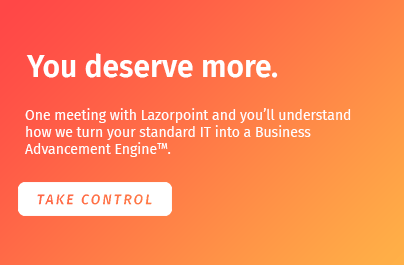 At Lazorpoint, companies work with us because we see more than just technology. We see entire businesses. Our job is to use this vision to enable businesses to use technology to decide quickly, operate efficiently and grow smartly. The following six components of business IT planning are key parts of building that roadmap to success.
At Lazorpoint, companies work with us because we see more than just technology. We see entire businesses. Our job is to use this vision to enable businesses to use technology to decide quickly, operate efficiently and grow smartly. The following six components of business IT planning are key parts of building that roadmap to success.
Clarity Around Business IT Strategy
You might be surprised I’m suggesting that IT strategy starts with understanding your business strategy. Most mid-sized growth organizations are not clear on who their core customer is, either from a demographic or, more importantly, from a psychographic perspective. They aren’t clear on the tangible and emotional benefits that their product or service provides that sets them apart from the competition and the key reasons their core customers keep coming back.
GE Aviation’s (GE) success in transforming the airline industry gives us a great example of how a company’s IT plans were first dictated by its business strategy. For context, it’s good to understood that a major factor in the success of GE’s customers (airlines) is managing fuel costs. To address this customer need, GE introduced innovative sensors in its engines which collect an average of 1 Terabyte of data per flight. GE analyzes this data and advises pilots on changes they can make to fly more fuel efficiently. It also uses the data to maintain engines in a way that improves fuel efficiency, safety and engine longevity. Instead of airlines paying a one-time capital expense for the engine, they pay GE for the engine and their services as a fee.
At a high-level, if your IT plan doesn’t align with the most important elements of your business plan, then you will likely invest in the wrong things or at the wrong levels and attract the wrong customers, preventing you from executing your business IT strategy.
The Right IT Structure & Team
IT, like most areas of business, sales, marketing, accounting and operations, is a team sport. However, most mid-sized growth companies aren’t large enough to afford an internal IT team that is fully staffed with people that have all the required competencies. Instead, company leadership makes the mistake of putting the responsibilities of a full IT team on the shoulders of one or a few internal IT people. This, ultimately, leads to large problems that not only cost the organization a significant amount of money, but also negatively affects the company’s reputation with its customers and employees.
Because of the lack of experience and knowledge around IT, the leadership team also doesn’t provide the adequate oversight around technology that ultimately enables the business to operate efficiently and grow smartly. If you are not confident that you have the right structure and oversight for IT, look for some outside help that has the expertise in building IT teams.
Great IT Budgeting
IT budgeting, like any type of budgeting, in its simplest form is about planning for future expenses. Once you have clarity around your short- and long-term goals, only then can you accurately budget for IT expenses and develop a roadmap to ensure success.
The two main components of an IT budgeting process are purchasing costs and maintenance costs. On average, companies spend more than half their IT budgets on maintaining existing systems and not on improvements that advance their business. New systems, applications and hardware don’t just have a one-time acquisition cost.
The total cost of ownership could include the costs to maintain them, lost productivity of workers when they don’t work, training expenses, etc. As you add new systems, your IT budget will likely need to grow to accommodate the ongoing costs associated with owning and operating a new system. When budgeting for IT, make your decisions carefully with an understanding of the total cost of a solution, not just the cost of purchasing it.
IT Processes Management and Frequency
In your business, you have seen the importance of how good business process management establishes clear processes that optimize your outcomes. As your business has grown, you have seen how those processes have evolved to meet changing needs. IT process management is similarly essential in meeting the needs of a rapidly changing IT environment. This formal IT planning process is crucial in deciding how to select, upgrade, implement and maintain new and current systems.
The right frequency of the planning process varies from one company to the next, but for companies that are growing and transforming, major planning should happen annually with reviews and adjustments every six months, and for many, quarterly. This frequency might mirror that of your business planning rhythms.
Solid IT Foundation
During your IT strategy processes – before committing to IT projects that will advance your business and set it apart from your competitors – it’s best to make sure that you’ve got the IT basics down. Just as building a home on top of quicksand is an unwise choice, thinking you can build and implement new capabilities on top of a weak IT infrastructure is foolhardy. To keep things solid, make sure you are planning and budgeting enough to maintain a robust IT foundation that can support new strategic initiatives.
Change Management
Leadership and the rest of the company need to view IT projects as business projects that are integral to the success of the company. Everyone must be involved to achieve success. Constant communication is key in helping teams understand why these projects are necessary.
Like all strategic projects, there are risks and unknowns that can impact your business. Ideas can sound great on a whiteboard and in a conference room, but once the team starts executing, new things will come to light that impact the project. Instead of charging forward and going all-in on a project, your company should set up an iterative process of planning, piloting and regularly adjusting the plan until you get to your desired outcome.
At Lazorpoint, our client relationship begins with strategic IT planning. By working collaboratively on your IT roadmap, we share our years of experience and unique insights to determine the technology best suited for your operations. We then take that roadmap and make it a reality with solutions that are best aligned for your business strategy while simultaneously making your business work faster, smarter and safer.

